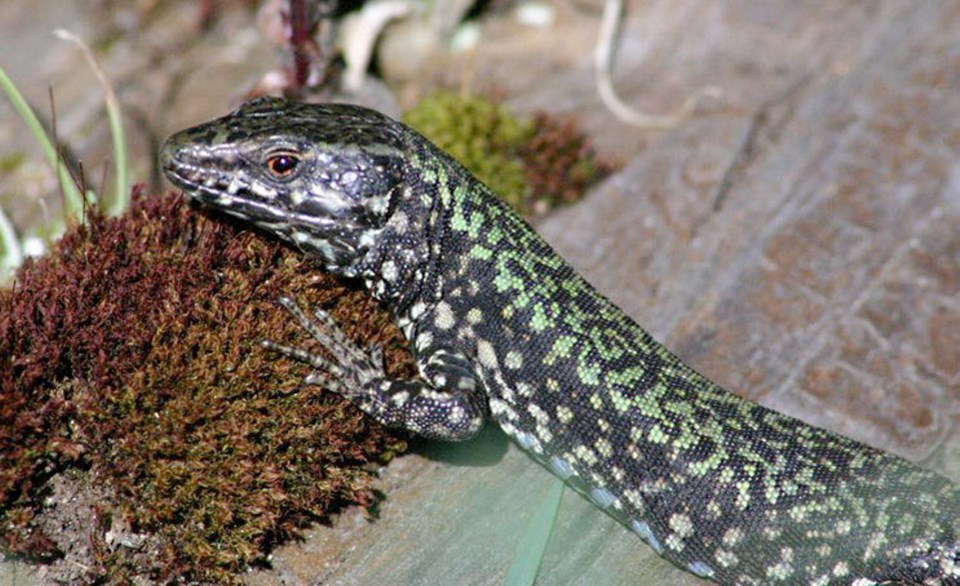 Was tending the tomato plants, feeling vaguely Amish, when something scaly and reptilian skittered up the rock wall.
Was tending the tomato plants, feeling vaguely Amish, when something scaly and reptilian skittered up the rock wall.
I stuck my head in the house: “Vladimir Putin is in the garden.”
She shook her head: “European wall lizard.”
I blanched. “No need to call me names.”
“No,” she said. “It’s a European wall lizard. Non-native species that is spreading around Victoria, just like grey squirrels, American bullfrogs and Albertans.”
“Right,” I replied. “Where are the shotgun shells?” One minute you think you have a nice backyard, next thing you know it’s Jurassic Park. …
This is how we tend to react to lizards. With the exception of the GEICO gecko, they get a bad rap in popular culture. Spider-Man has an arch-villain named the Lizard. Sleazy guys are lounge lizards. When Edwin Edwards, the corrupt governor of Louisiana, ran against a former leader of the Ku Klux Klan, the bumper stickers read: Vote For The Lizard, Not The Wizard.
Victorians, who would, without a second thought, take a bullet for a UVic bunny, turn positively primal when encountering reptiles, flailing at them with garden implements and flaming patio tiki torches.
Hold on, no reason to freak out. The spread of the wall lizards began more than 40 years ago. They will not eat you or your pets (unless you have a pet cricket). “They eat insects,” Christian Engelstoft says. “They keep your garden free of bugs.”
Engelstoft is a wildlife biologist with the Habitat Acquisition Trust, a Victoria-based nature conservancy. He has been watching the lizards with a scientist’s eye, trying to figure out what their presence means to the rest of the natural world.
“Empirically, we don’t know what the impact is.” Some wonder if the newcomers will drive out the native alligator lizards, though few of those are found in built-up areas as it is. Speculation is that wall lizards might compete for egg-laying space with sharp-tailed snake (harmless, native to Vancouver Island, and in need of help), but Engelstoft has also heard of them sharing the same patch just fine.
It’s never a good idea to let an introduced species spread, though. So although the wall lizards are so well established here that it would be pointless to try to eradicate them, we should still try to stop them from going any farther.
Hard to stop an animal that moves so quickly, though. As the name suggests, they like rock walls, their long toes making them terrific climbers. Growing to the length of your hand, they’re amazingly fast and nimble, just like Chicago winger Patrick Kane, but more likable.
“They are fun to watch,” Engelstoft says. Difficult to catch, though. Even if your ninja-like reflexes allowed you to grab one, you might just find yourself holding nothing but a tail.
The wall lizards are native to northern Italy and the south of France. No one is sure how they got from there to here, though we do know that the local Ground Zero is just south of Brentwood Bay.
There are a couple of stories about how they spread from there. For a long time, accepted wisdom said the lizards either escaped or were freed when Rudy’s Pet Park, a private zoo on Durrance Road, closed in 1970. But then Engelstoft got a call from a man saying he had let loose a single pair in 1967.
In either case, the lizards radiated out. Plenty are found in the southern end of Brentwood Bay. “Central Saanich is the hot spot,” Engelstoft says. Pockets have taken hold elsewhere on the Saanich Peninsula, on Triangle Mountain, in James Bay, the Gorge, even Mill Bay and elsewhere up-Island now.
It’s known that they spread in a couple of ways. Some get trapped in hay bales that get sold by one farmer to another. Most commonly, it’s a matter of kids catching them, then releasing them at home. Don’t do that, Engelstoft says.
“We are very interested in trying to curb the spread,” he says. Don’t want them showing up in the Gulf Islands or on the Lower Mainland.
Scientists are keen on mapping the critters. If you see one, they would like you to record the find at alienspecies.royalbcmuseum.bc.ca. You can also email Engelstoft at christian@hat.bc.ca.
No need to break out the shotgun, though.



